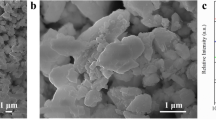Abstract
The results of concentration cell electromotive force methods (EMF) and electrochemical impedance spectroscopy measurements on the pyrochlore system Sm1.92Ca0.08Ti2O7–δ are presented. The data have been used to estimate total and partial conductivities and determine transport numbers for protons and oxide ions under various conditions. The EMF techniques employed include corrections for electrode polarisation resistance. The measurements were performed using wet and dry atmospheres in a wide \( {p_{{{{\rm{O}}_{{2}}}}}} \) range using mixtures of H2, N2, O2, and H2O in the temperature region where proton conductivity was expected (500–300 °C). The impedance measurements revealed the conductivity to be mainly ionic under all conditions, with the highest total conductivity measured being 0.045 S/m under wet oxygen at 500 °C. Both bulk and grain boundary conductivity was predominantly ionic, but electronic conductivity appeared to play a slightly larger part in the grain boundaries. EMF data confirmed the conductivity to be mainly ionic, with oxide ions being the major conducting species at 500 °C and protons becoming increasingly important below this temperature.






Similar content being viewed by others
References
Iwahara H (1995) Solid State Ionics 77:289–298
Scherban T, Nowick AS (1989) Solid State Ionics 35:189–194
Bonanos N, Ellis B, Mahmood MN (1991) Solid State Ionics 44:305–311
Ahmed I, Eriksson SG, Ahlberg E, Knee CS, Berastegui P, Johansson LG, Rundlöf H, Karlsson M, Matic A, Börjesson L, Engberg D (2006) Solid State Ionics 177:1395–1403
Kreuer KD (2003) Annu Rev Mater Res 33:333–359
Yamamura H, Nishino H, Kakinuma K, Nomura K (2003) J Ceram Soc Jan 111:902–906
Kramer SA, Tuller HL (1995) Solid State Ionics 82:15–23
Omata T, Okuda K, Tsugimoto S, Otsuka-Yao-Matsuo S (1997) Solid State Ionics 104:249–258
Labrincha JA, Frade JR, Marques FMB (1997) Solid State Ionics 99:33–40
Omata T, Otsuka-Yao-Matsuo S (2001) J Electrochem Soc 148:E252–E261
Fjeld H, Haugsrud R, Gunnaes AE, Norby T (2008) Solid State Ionics 179:1849–1853
Eurenius KEJ, Ahlberg E, Ahmed I, Eriksson SG, Knee CS (2010) Solid State Ionics 181:148–153
Gorelov VP (1988) Elektrokhimiya 24:1380–1381
de Grotthuss CJT (1806) Ann Chim 58:54
Bentzer HK, Bonanos N, Phair JW (2010) Solid State Ionics 181:249–255
Liu M, Hu H (1996) J Electrochem Soc 143:L109–L112
Fleig J, Maier J (1998) J Electrochem Soc 145:2081–2089
van Dijk T, Burggraaf AJ (1981) Phys Status Solidi A 63:229–240
Verkerk MJ, Middelhuis BJ, Burggraaf AJ (1982) Solid State Ionics 6:159–170
Eurenius KEJ, Ahlberg E, Knee CS (2010) Solid State Ionics 181:1577–1585
Potter AR, Baker RT (2006) Solid State Ionics 177:1917–1924
Acknowledgements
This work has been supported by the Swedish Research Council (Vetenskapsrådet) and by Risø-DTU as part of the project “Initiatives for Hydrogen Separation Membranes”.
Author information
Authors and Affiliations
Corresponding author
Rights and permissions
About this article
Cite this article
Eurenius, K.E.J., Bentzer, H.K., Bonanos, N. et al. Intermediate temperature ionic conductivity of Sm1.92Ca0.08Ti2O7–δ pyrochlore. J Solid State Electrochem 15, 2571–2579 (2011). https://doi.org/10.1007/s10008-010-1235-1
Received:
Revised:
Accepted:
Published:
Issue Date:
DOI: https://doi.org/10.1007/s10008-010-1235-1




